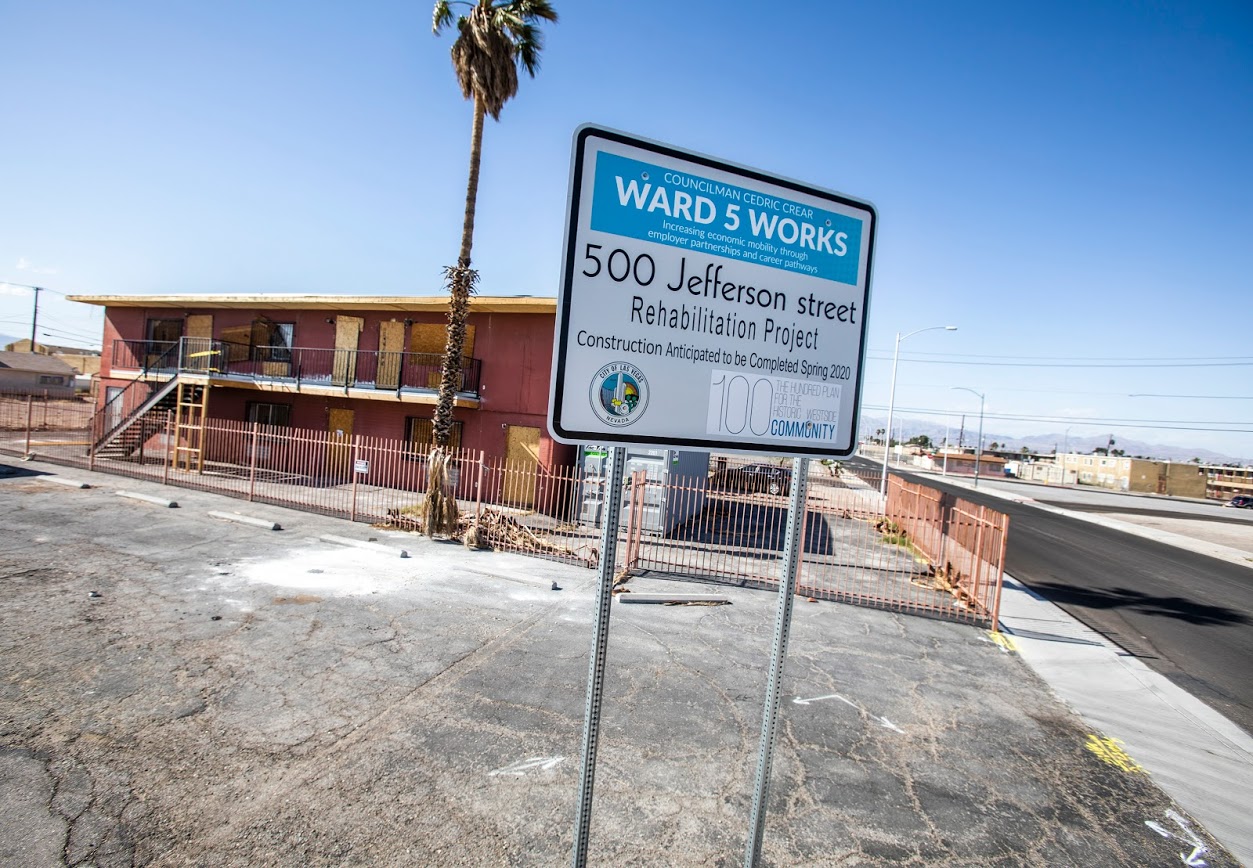Indy Explains: How have discriminatory housing practices shaped Vegas’ Historic Westside?

Editor’s note: This story was produced as part of the Nevada Democracy Project, a collaboration between The Nevada Independent and Vegas PBS to increase civic engagement.
Ninety-three-year-old Ernesten Cooks said with $100 down, she bought five properties in Las Vegas’ Historic Westside neighborhood in the summer of 1953 to provide housing options to family members.
She said over the years, the community has fallen into disrepair, but she likes the recent reconstruction along Jackson Avenue that involved $6.5 million in enhancements such as trees, updated street lights, bicycle lanes and new pavement that widens the road.
“They used to say that they were going to open the street back up,” Cooks said in an interview with Vegas PBS and The Nevada Independent. “We'd always say, ‘Well how can you open the street with all these old buildings?’ But I've lived long enough to see that they did open it.”
The historically Black community has gone through decades of underinvestment and shrinkage, which led several residents at the first Nevada Democracy Project community listening session, co-hosted by The Nevada Independent and Vegas PBS, to sound the alarm alert that harms from redlining still ripple through the Historic Westside today and hold back the economic prosperity of the neighborhood.
Redlining can refer to specific areas where the Federal Housing Authority would not extend loans because the neighborhoods were predominantly Black. But housing experts believe redlining was still carried out in Nevada even though maps of those areas don’t exist, stating that the term “encompasses” segregationist housing policies carried out by state, federal and local governments, and racist social practices that mainly targeted Black communities.
One listening session attendee who spoke about the practice was Chandler Cooks, 30, the grandchild of Ernesten Cooks who is set to inherit her remaining properties — a four-plex and a house. He said he looks forward to taking over the properties but that it will be a challenge because of inflation, his $100,000 student loan debt, gentrification pressures and the “trickle down effects” from redlining.

“We can look at the growth of this area in comparison to other areas,” he said. “We can see how redlining was detrimental.”
Chandler Cooks said infrastructure upgrades in the area are necessary, stating that there was a need for more water lines, cell towers, fiber optics and increased access to parks.
“All of that affects property value,” he said. “All of the vacant lots that you see on the west side, all of the buildings that burned down … the dilapidation — that affects the property value.”
Redlining and the wealth gap
Housing policy researchers Richard Rothstein and his daughter Leah Rothstein said that despite investments in the area, the damage has already been done and that new resources only deal with modern-day symptoms. He said because discriminatory practices were “blatantly illegal” and “unconstitutional,” the country has an obligation to provide a remedy.
“I think the biggest issue is the wealth gap that was created by the Federal Housing Administration and Veterans Administration policies, to suburbanize the entire country, for whites only,” said Richard Rothstein, who wrote the book The Color of Law: A Forgotten History of How our Government Segregated America. “It wasn't intended as a wealth generating program. Nobody knew that these homes were going to appreciate in value.”
Redlining was outlawed in 1968 through the Fair Housing Act, but the Rothsteins said the word is used in a more broad sense and extends beyond Black people being barred from Federal Housing Administration (FHA) backed loans, asserting that it also includes segregationist covenants and social practices that barred mainly African Americans from purchasing homes in white-only neighborhoods.
“Well today, the result of that policy is that African Americans, on average, have about 60 percent of family incomes that whites have,” he said. “But African American households have about 5 percent of the wealth that white households have.”
The Federal Reserve 2022 Survey of Consumer Finances found that net housing wealth was the biggest contributor to wealth growth that year, with the typical white family earning six times as much wealth as the typical Black family, and five times as much as the typical Hispanic family.
The survey stated that white families had a median wealth of $285,000 in 2022, compared to $44,900 for Black families and $61,600 for Hispanic families — while the typical Asian family holds $536,000 in wealth.
“The white families — with subsidized [support] from the federal government — gained wealth from the equity appreciation of their homes over the next couple of generations,” Richard Rothstein said. “They used that wealth to send their children to college, perhaps take care of temporary emergencies, like unemployment, or maybe a medical issue.”
No redlining maps for Nevada
According to the equity-focused National Community Reinvestment Coalition, the federal government made redlining maps for 140 metropolitan cities in the 1930s. No city in Nevada was on the list.
Richard Rothstein said that during segregation, the federal government was mainly focused on excluding African Americans and that redlining maps were created for states with large populations of Black people. He said there weren't many African Americans west of the Mississippi at that time and that an absence of maps does not mean there was an absence of redlining.
“The maps themselves didn't segregate anybody,” Richard Rothstein said. “It was the reluctance of banks, Realtors and developers to serve African Americans in segregated, low-income neighborhoods.”
An article in the Library of Congress states that from 1905 to 1933, “segregation tightened and racial oppression escalated” across the U.S. as African Americans migrated from the South, pouring into industrialized cities. The same was true for the growing Las Vegas Valley.
According to the timeline on the City of Las Vegas’ website, in 1929, anti-Black laws were enacted to remove African Americans from downtown Las Vegas, which uprooted Black homeowners and business owners, to “make way for growth and business expansion.”
Black residents of differing socioeconomic statuses were then relegated to the west side and redlined.
In 2023, KNPR reported that one in four residents in Las Vegas’ Historic Westside are food insecure, which is the highest rate in Las Vegas and the median household income is $34,000 a year, or half of the county’s average.
According to the U.S. Department of Health and Human Services, a person is food insecure when they have uncertain access to food that is nutritionally adequate because of low household income or lack of access to full-service supermarkets.
“[Redlining] is often used to encompass all of the policies that made African American neighborhoods areas of lower resource and less investment …. closer to industrial polluting companies, factories and freeways,” Leah Rothstein said. “Which then … hasn’t accumulated in value.”
